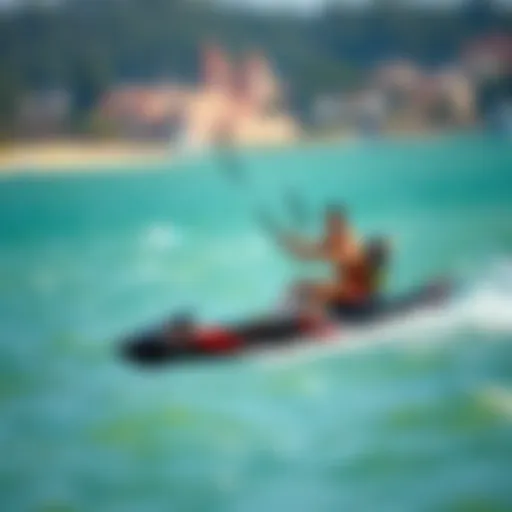The Ultimate Guide to Split Toe Booties for Kiteboarding
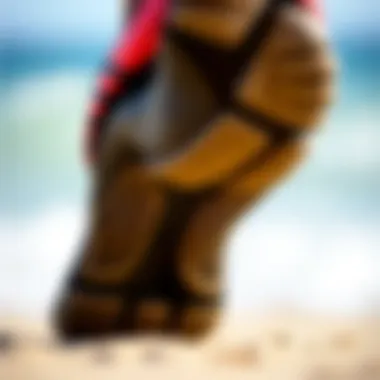
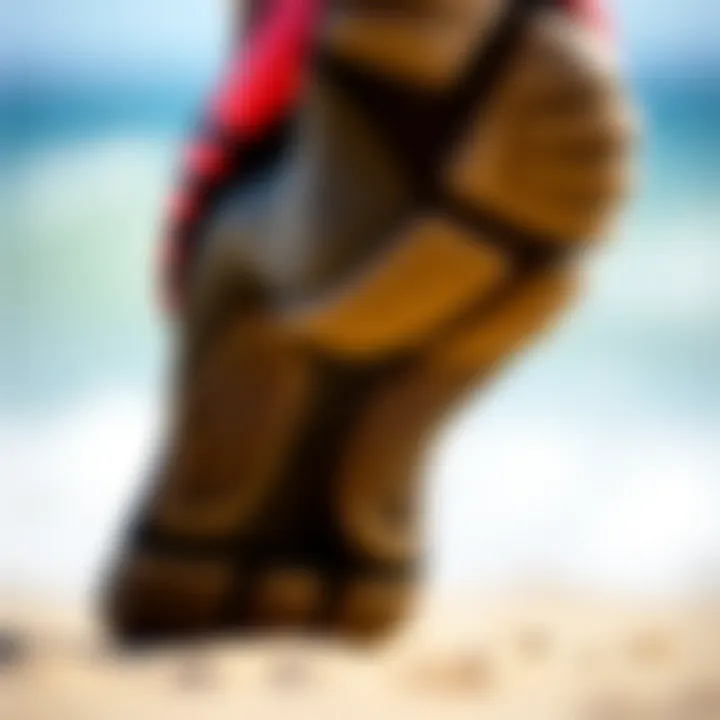
Intro
Kiteboarding is a thrilling sport, combining elements of surfing, windsurfing, and paragliding. For enthusiasts, having the right gear is crucial, and among these essentials, the split toe bootie stands out. This piece of footwear is not just a fashion statement on the beach; it plays a pivotal role in optimizing performance and comfort during kiteboarding activities.
Designed specifically for the rigors of this dynamic sport, split toe booties come with unique features that cater to both beginners and seasoned kiteboarders alike. Understanding these booties enhances the overall kiteboarding experience. From the materials used to the fitting, every detail matters. This guide will take a closer look at the features and benefits of split toe booties, providing insights that will help you make an informed decision when selecting your gear—ensuring that you hit the waves with the utmost confidence.
Gear Insights
When it comes to kiteboarding, having the right gear can make all the difference. This section explores various aspects of split toe booties, their significance in the sport, and critical insights into gear selection.
Latest Gear Reviews
In the market today, numerous brands are pushing the envelope with innovative designs and materials. Top choices among kiteboarding enthusiasts include:
- O'Neill Superfreak Split Toe Booties: Known for their comfort and flexibility, these booties utilize lightweight neoprene, perfect for those longer sessions on the water.
- Mystic Star Split Toe Booties: Featuring a sturdy grip sole, these are tailored for better traction and support during intense maneuvers.
- Ion Ballistic Split Toe Booties: With extra padding and a snug fit, they're ideal for riders looking for additional protection against harsh conditions.
Each option boasts unique aspects catering to different preferences. By diving into reviews on platforms like Reddit or social media groups, kiteboarders can weigh the pros and cons based on personal experiences.
Essential Gear for Beginners
For those new to kiteboarding, selecting the right split toe booties can be daunting. Here are some essentials to keep in mind:
- Fit and Comfort: Choose booties that feel snug yet comfortable. A good fit will enhance your control over the board.
- Material Quality: Look for neoprene booties that offer warmth without sacrificing flexibility.
- Traction: Opt for soles that provide excellent grip on the board and when walking on the beach. This is crucial, especially when dealing with wet conditions.
A good way to start is by visiting kiteboarding forums or checking recommendations on sites like Wikipedia for gear reviews.
Techniques and Tips
Understanding your gear is just part of becoming a proficient kiteboarder. This section discusses advanced techniques and essential safety practices for an enjoyable experience on the water.
Advanced Tricks and Techniques
As you progress in kiteboarding, mastering advanced tricks can be exciting yet challenging. Consider practicing maneuvers such as the kite loop, backroll, or handle pass. Each trick requires confidence and familiarity with your equipment. Practicing in shallow, calm waters can provide a safer environment for learning these techniques without the worry of deep water mishaps.
Safety Practices for Kiteboarders
Safety should always be a priority. Here are some best practices:
- Pre-Flight Checks: Always inspect your gear before hitting the water, ensuring everything is in perfect condition.
- Know Your Limits: It's easy to get carried away, but knowing when to draw the line is essential for safety.
- Environment Awareness: Pay attention to wind conditions and obstacles in the water. Staying alert can make a significant difference in your safety.
"Proper preparation prevents poor performance. Always evaluate weather conditions and gear before heading out."
By integrating these practices into your routine, you can foster a safer and more enjoyable kiteboarding experience.
Epilogue
The right split toe booties can elevate your kiteboarding experience, providing comfort, stability, and protection while out on the water. Whether you're a beginner or an advanced kiteboarder, understanding gear selection, techniques, and safety practices will steer your journey towards becoming a better rider. With the right knowledge, you’ll be set to tackle waves with confidence and flair.
Prolusion to Split Toe Booties
With the winds kicking up and the waves begging for attention, kiteboarding demands not just skill but also the right gear. Among the unsung heroes of this sport is the split toe bootie, footwear often overlooked yet crucial for performance and comfort. This section serves as a gateway into understanding what split toe booties are all about, why they matter, and what kiteboarders should consider when selecting their next pair.
Defining Split Toe Booties
Split toe booties, as the name suggests, feature a design that separates the big toe from the other toes. This structure resembles a sandal but offers the warmth and protection typically provided by traditional booties. Kiteboarding enthusiasts favor these foot coverings for their unique benefits that enhance both grip and balance on the board. Unlike standard booties that might feel too restrictive, split toe booties afford more flexibility, allowing for a more natural movement of the foot.
"It’s like having your cake and eating it too – the comfort of a bootie with the control of bare feet."
This balance is essential when performing tricks or making quick directional changes in the water. The enhanced sensitivity between your foot and the board can make all the difference when you’re carving up the waves.
Historical Context and Development
The evolution of split toe booties is rooted in the demand for more versatile and specialized kiteboarding gear. Originally, kiteboarders relied on standard surf booties, which often led to discomfort and a lack of control when striding on the board. The late 1990s and early 2000s saw the rise of the split toe design, a breakthrough attributed to a few forward-thinking surfers and water sports enthusiasts who wanted more from their footwear.
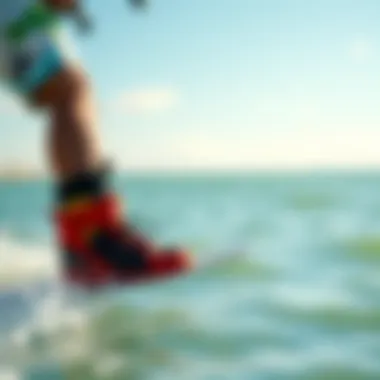
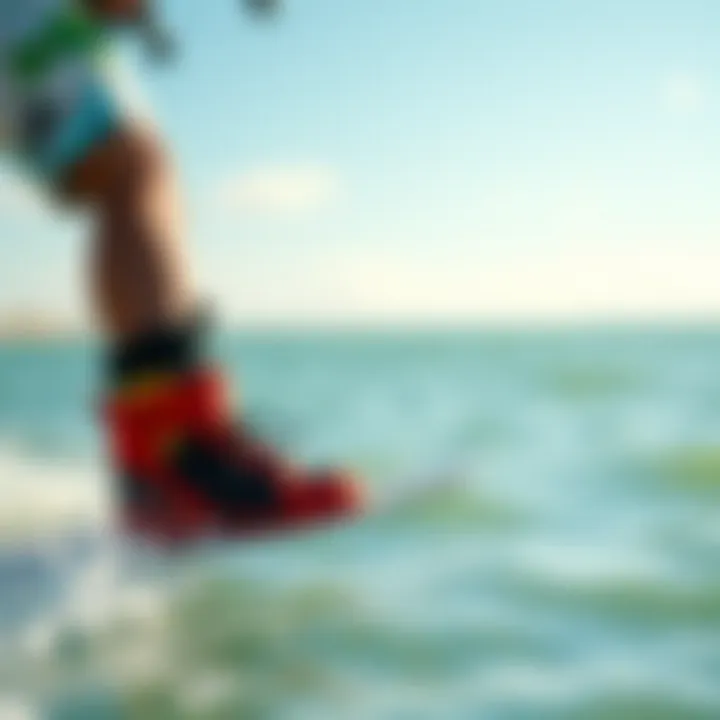
Manufacturers began experimenting with various materials and designs, taking inspiration from both surfing and other water sports. Brands like O’Neill and Ion led the charge, introducing versions that blended innovative technology with the traditional look, enhancing performance capabilities.
As kiteboarding gained popularity, so did the need for gear that catered specifically to those conditions. Split toe booties became not only a choice but a necessity for those serious about the sport. Today, the development of these booties continues to evolve, integrating new materials and technologies that promise even greater comfort, durability, and performance on the water.
Therefore, understanding the historical context helps appreciate the split toe bootie not just as a piece of gear but as a result of years of innovation, driven by enthusiasts passionate about kiteboarding.
Why Choose Split Toe Booties?
In the world of kiteboarding, the right gear can make all the difference between a thrilling experience and a frustrating one. Among the essentials, split toe booties stand out for their unique design and functionality. But what exactly sets them apart from traditional booties? In this section, we’ll dive into the fundamental reasons to opt for split toe booties and their advantages, as well as how they can enhance your overall performance on the water.
Advantages over Traditional Booties
Split toe booties present a compelling case for kiteboarders looking to improve their outdoor adventures. Here are several critical advantages:
- Enhanced Toe Control: The separation of the big toe from the rest allows for increased grip. When on the board, this means more precise movements and better overall balance. No more slipping around like a fish out of water!
- Increased Comfort: Traditional booties can often feel constraining, especially in warmer weather. Split toe designs tend to offer more freedom and flexibility, which, after hours on the water, is a blessing.
- Better Board Sensitivity: With your toes split, your feet get to experience the board more directly. This connection fosters an intimate feel for what’s happening beneath you, letting you react more swiftly to the demands of the wind and waves.
- Durable Construction Options: Many split toe booties are made with high-quality neoprene or other robust materials, making them both resilient and comfortable. They can face harsh conditions without falling apart, ensuring you can ride hard without worries.
"Choosing the right bootie is not just about style. It's about function, control, and comfort while keeping you in the zone during those epic sessions on the water."
This enhanced feel and control can not only boost your confidence but also your skill level. Importantly, you want gear that doesn’t hold you back.
Impact on Performance
Utilizing split toe booties can have a direct correlation with your performance on the water. Here’s how:
- Improved Maneuverability: The ability to flex the big toe independently increases your control over the board during maneuvers. This is crucial when navigating through changing winds or tight turns. When you’re making split-second decisions, having all ten toes working in harmony matters.
- More Efficient Power Transfer: When a kiteboarder executes tricks or navigates with force, the efficiency of energy transfer from feet to board becomes vital. With split toe booties, this transfer is seamless, allowing for better jumps and spins.
- Adaptability to Variability: Whether tackling choppy waters or smooth winds, the split bootie's grip ensures stability regardless of conditions. Riders often find that they can adapt their riding style more fluidly when they can actively use their toe dexterity.
In summary, choosing split toe booties is not just a matter of preference; it is a decision that caters directly to the demands of kiteboarding. Their thoughtful design encapsulates the need for enhanced control, comfort, and connection to the board, ultimately leading to an improved overall experience on the water.
Key Features of Split Toe Booties
When examining split toe booties, it's essential to focus on the specific elements that contribute to their effectiveness. These include the material composition, fit and comfort, which directly impact performance and longevity on the water. Understanding these features allows kiteboarding enthusiasts to make informed decisions, ensuring that their footwear enhances their overall experience while navigating the waves.
Material Composition
The material choice plays a significant role in how split toe booties perform in various conditions. Typically, the primary materials are either nylon or neoprene, each contributing differently to comfort, durability, and flexibility.
Nylon vs. Neoprene
Nylon is known for being lightweight and durable, making it an attractive option for many kiteboarders. The fabric allows for quick drying, which is a boon during those sun-soaked sessions on the water. However, it often lacks the stretch and insulation properties of neoprene. On the other hand, neoprene is widely praised for its thermal regulation abilities. This makes it an excellent choice for colder environments, keeping feet warm and buoyant. While neoprene may be bulkier, it provides a snugger fit that many riders prefer.
"Choosing between nylon and neoprene often boils down to the conditions you anticipate facing. Warm weather enthusiasts may lean toward nylon, while those braving chillier waters might opt for neoprene."
Durability Considerations
Durability is another pivotal aspect of any split toe bootie. The material's ability to withstand wear and tear, especially from repeated exposure to saltwater and sun, plays a vital role in the lifespan of the booties. Brands that prioritize reinforced stitching and high-quality materials can generally offer better durability. In addition, the construction techniques such as blind stitching can help further enhance overall robust build.
A well-constructed bootie can see more seasons on the water. Riders who regularly use high-performance gear will benefit from investing in options that emphasize durability. This investment often translates to long-term savings as the need for replacements diminishes.
Water Resistance
Water resistance is crucial; it's about keeping your feet dry while ensuring that water doesn't seep into your booties. Most split toe booties incorporate water-resistant materials that provide a barrier against splashes and waves. However, the true measure of water resistance lies in the construction—sealed seams and careful stitching techniques help prevent water from entering the bootie.
For kiteboarders in rough waters, having reliable water-resistant gear allows for prolonged enjoyment without the discomfort of soggy feet. Drawbacks may surface as water resistance can sometimes affect breathability, especially if ventilation is compromised.
Fit and Comfort
Fit and comfort are paramount when engaging in extroaordinarily moving sports like kiteboarding. A poorly fitting bootie can not only hinder performance but also lead to discomfort during long sessions, turning your adventure into a chore.
Toe Separation Benefits
One of the most notable features of split toe booties is their unique design allowing for toe separation. This form enhances balance by providing better articulation compared to traditional full-finger designs. Riders often find they have enhanced control over movements, which is particularly beneficial during quick transitions or while maneuvering through choppy conditions. While some might feel a bit of a learning curve adjusting to the split design, the benefits typically outweigh the initial awkwardness.
Sizing Guidelines
Getting the right size is critical. Adhering to sizing guidelines can make all the difference. Many brands offer a sizing chart, helping kiteboarders find their perfect fit. It's advisable to try on several styles and sizes, as each brand may have slight variations in how they fit. Remember, a snug fit is essential, but you should never feel constricted. Look for a little wiggle room in your toes for ultimate comfort on the water. Too tight, and you'll find yourself sacrificing circulation; too loose, and you'll lose control.


In summary, understanding the key features of split toe booties—including material choices, durability, water resistance, and comfort factors—is essential for kiteboarders looking to elevate their riding experience. Selecting the right pair based on these considerations sets the stage for successful days on the water.
Selecting the Right Split Toe Booties
Finding the perfect split toe booties is more than just a simple shopping task; it’s about honing in on the gear that aligns with your unique kiteboarding experience. Selecting the right footwear can significantly influence your comfort and performance on the water. As a kiteboarder, investing time and thought into this selection process can pay off in spades, ensuring that your time spent riding is enjoyable rather than hindered by poorly fitting or inappropriate gear.
Assessing Your Needs
Skill Level Considerations
When it comes to skill level, the type of split toe booties you choose can vastly impact your performance. Novice kiteboarders often find that more cushioned and stable booties, like those from Ion or Mystic, provide the support needed while they're still mastering their balance on the board. These booties typically feature thicker soles and additional padding that can soften any knocks you might take while learning. On the flip side, advanced riders might gravitate towards a more streamlined model—something that offers less bulk and more flexibility, like the ones made by Crazy Fly. This allows for more freedom of movement and an improved connection with the board.
Ultimately, selecting booties that match your skill level can mean the difference between comfort and frustration on the water.
Local Weather Effects
Weather plays a crucial role in bootie selection as well. For instance, if you’re gearing up for a session in the chilly waters of the Pacific Northwest, you'd need boots crafted from thicker neoprene that provide ample insulation, such as those by O’Neill. Conversely, if you’re kiteboarding in the warm tropics, a lighter-weight and more breathable boot, like the ones from Seac, might be your go-to choice.
The temperature of the water can also affect your overall endurance out there, so making the right call based on local weather patterns is not only wise—it’s imperative. You may want to keep an eye on the forecasts to adapt your gear choices accordingly.
Analyzing Fit and Style
Trial and Testing
Trial and testing is paramount before committing to a pair of split toe booties. It’s the best way to understand how they feel on your feet during the actual activity. Not every brand fits the same, and you could find yourself in a totally different realm when trying various models, even among those that appear similar at a glance. Many shops like REI allow you to try on boots and mimic the motion of kiteboarding to see how they hold up.
Trying on several pairs might take longer, but it will likely save you from the heartache of unwanted blisters or aching arches on the water. Seek booties that have a snug fit without being uncomfortably tight; not a cakewalk, but worth it when you find that balance.
Brand Comparisons
Brand comparisons can lead you down diverse paths. Each brand brings its own flavor to quality, performance, and aesthetics. For instnace, brands like Rip Curl often excel in optimal grip and traction, while certain models from Dakine are known for their stylish designs alongside enduring reliability.
When you compare how these booties perform in various conditions, style can shouldn’t be your sole focus. The quality of the material, the durability, and customer reviews can give you insight into what will serve you best based on where you kiteboard. Take the time to digest what other users say, and think about how you want your kickers to complement your gear as a whole.
By assessing your needs, honing in on fit and style, and doing your homework on brand performance, you’ll be setting yourself up for success on the water. Selecting split toe booties isn't just a mundane task—it's a strategic move toward enhancing your kiteboarding experience.
Using Split Toe Booties in Different Conditions
When kiteboarding, the environment can greatly influence your experience on the water. This makes understanding how to use split toe booties in various conditions vital for every kiteboarding enthusiast. Wearing the right gear not only enhances your agility but also safeguards against the elements. Let’s dive into two primary climatic considerations that every kiteboarder should keep in mind: warm weather versus cold weather and shallow water conditions.
Warm Weather vs. Cold Weather
Kiteboarding during warmer months means dealing with heat and sun exposure, which can be quite taxing without the right gear. Split toe booties designed for warm weather usually use lightweight materials, allowing for breathability while still providing necessary grip on the board. They are typically made of thinner neoprene, which helps in keeping your feet cool. However, it’s essential to ensure they fit snugly. A loose fit may result in sand and water getting inside, which could become a nuisance.
In contrast, navigating the waters in cold conditions can present a different set of challenges. Here, thicker neoprene materials are crucial. These booties are usually lined with thermal insulation to retain warmth, keeping your toes from going numb. When temperatures plummet, a good grip becomes even more critical as waves can become choppy. Split toe designs in cold weather options help provide stability and comfort, allowing you to maintain control over your board, even when water temperatures dip.
"Choosing the right booties for the weather conditions not only enhances performance but ensures safety and comfort on the water."
Shallow Water Considerations
Kiteboarding in shallower waters calls for some specific adjustments regarding your foot gear. Shallow water conditions often bring forth various obstacles like rocks, coral, or sharp shells. Hence, using split toe booties in this environment is beneficial due to their protective elements. The split toe design allows for more natural foot movement and better control, which is essential when navigating over uneven surfaces.
Additionally, if you find yourself in areas with fluctuating water levels, a snug fit becomes even more crucial. A well-fitted split toe bootie prevents slipping, ensuring your feet remain secure on the board. Notably, your booties should possess a durable sole as it helps in protecting your feet from sharp objects that may be present at the bottom.
In sum, understanding and adapting to various weather conditions can significantly impact your kiteboarding experience. Whether it's wearing lighter materials for the heat or thicker, insulated ones for the chill, ensuring your split toe booties meet these conditions is a game changer. Likewise, when venturing into shallow waters, selecting booties with a rugged design keeps you safe from potential hazards beneath the surface, allowing for an enjoyable ride.
Maintenance and Care of Split Toe Booties
Proper maintenance and care of split toe booties is often overlooked, yet it plays a vital role in keeping them functional and prolonging their lifespan. According to the folks who spend significant time out in the water, neglecting your gear can lead to performance issues and costly replacements. Routine upkeep not only ensures your booties stay comfortable but also optimizes your time on the water, enhancing overall kiteboarding experiences.
Cleaning Techniques
To maintain these specialized booties, you must develop a robust cleaning routine. Here are two crucial elements of bootie maintenance that should be part of every kiteboarding enthusiast's regimen.
Post-Session Rinse
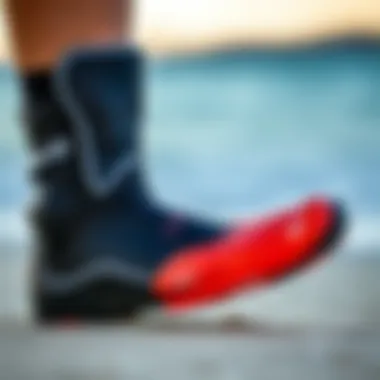
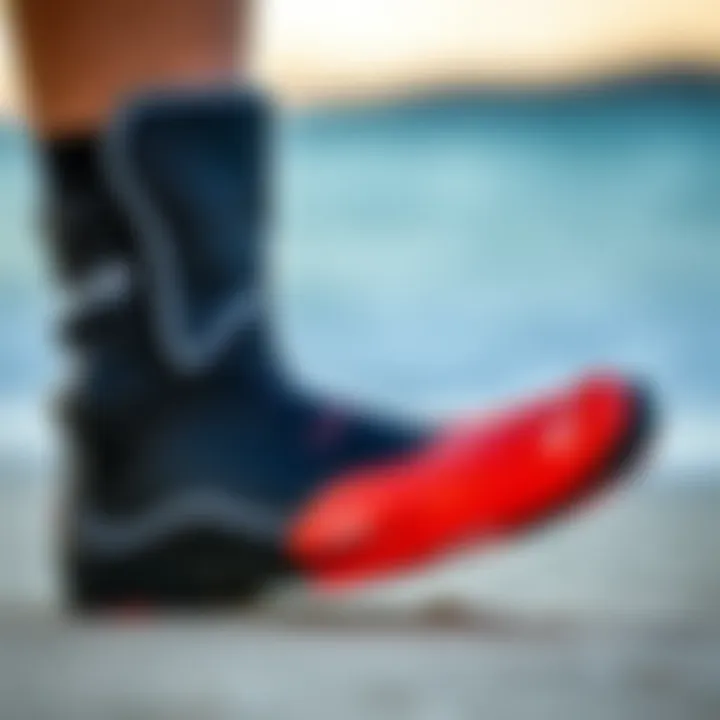
One of the most effective and simplest methods of maintaining split toe booties is by performing a post-session rinse. This technique involves rinsing your booties with fresh water immediately after use. Saltwater and sand can be corrosive, leading to deterioration over time, so getting rid of these contaminants is essential.
The key characteristic of a post-session rinse is its simplicity—you only need fresh water, which makes it a universally accessible choice for any kiteboarder. By regularly rinsing, you prevent buildup that’s notorious for compromising material integrity and performance.
Unique Features and Advantages:
- Prevents salt and sun damage which are major culprits of wear.
- Only takes a few minutes but can extend the life of the booties considerably.
Disadvantages:
- Some users might forget or skip this step due to exhaustion after a session.
Storage Recommendations
Proper storage of split toe booties is equally important. After a rinse, ensuring that they’re dried and stored correctly makes a world of difference. You wouldn’t toss your favorite shoes into the closet; the same goes for your booties. Keep them in a cool, shaded area and avoid folding them or cramming them into tight spaces.
The emphasis on storage comes down to maintaining shape and preventing cracks in the materials, which is a common issue when gear isn't stored correctly. Proper storage methods help maintain flexibility and overall performance, extending the life of the booties.
Key Points:
- Store booties upright or laid flat to avoid creasing.
- Avoid prolonged exposure to direct sunlight during storage.
Unique Features and Advantages:
- Greatly reduces the risk of material degradation.
- Keeps your booties ready for immediate use with minimal preparation.
Signs of Wear and Tear
It’s important to keep an eye out for telltale signs of wear and tear on your split toe booties. Like any sporting gear, they endure considerable strain on the water. Keep a vigilant approach; small tears or excessive stretching can lead to more profound problems.
Being aware of when it’s time to replace your booties—say if you spot discoloration, loss of elasticity, or any uncomfortable fits—can ensure that you remain at the top of your game in kiteboarding. After all, a solid pair of booties can be a game changer, so treat them with the care they deserve to keep riding the waves in style.
Innovations in Bootie Design
The world of kiteboarding is evolving, and so are the innovations in bootie design, especially in split toe varieties. These advancements are not just about aesthetics; they tangibly improve performance, comfort, and longevity, factors that matter significantly to both amateurs and veterans of the sport. Understanding these innovations sheds light on how technologies have shaped what we wear while riding the waves.
Emerging Technologies
3D Printing Applications
3D printing stands at the forefront of revolutionizing bootie design, allowing for customized and lightweight structures. With the ability to create intricate shapes and precise fits, 3D printing responds to individual preferences and needs of kiteboarders. Moreover, this technology can enhance comfort by mimicking the complex contours of the foot, which traditional manufacturing methods often overlook.
A unique feature of 3D printing in bootie design is the incorporation of breathability within the structure. Various patterns and designs can be printed directly into the material, resulting in improved ventilation. This minimizes clamminess and ensures the foot remains dry during those long sessions on the water. The downside? Cost can be a factor since custom 3D-printed booties can be pricier than mass-produced counterparts.
Smart Material Integration
Smart materials represent another leap forward. These materials adjust to changing conditions, providing flexibility and support as needed. Think of them as your personal assistant, adapting to your foot position. One of the most significant characteristics of smart materials is their temperature-sensitive properties. On a hot day, they can soften and become more forgiving; conversely, in colder conditions, they stiffen to offer better protection.
The standout feature of integrating smart materials into booties is the balance they offer between flexibility and stability. In kiteboarding, where foot positioning is critical for performance, this adaptability can mean the difference between a smooth ride and a wipeout. However, it’s essential to note that smart materials may require special maintenance to ensure longevity, which could be a consideration for less experienced riders.
Trends in Aesthetics
The aesthetics of split toe booties have shifted dramatically, mirroring the personal style of kiteboarders today. No longer just functional, booties now come in various colors, patterns, and designs, making it easier for riders to express their individuality on the water. This trend isn’t superfluous; it reflects a lively community where kiteboarding is not only a sport but an expression of identity. With several brands merging functionality with a touch of flair, kiteboarders can find booties that both fit well and look great.
End
As we wrap up this exploration of split toe booties, it's crucial to recognize their role in improving the kiteboarding experience. From enhancing grip and control to offering protection in diverse water conditions, these booties represent more than just footwear; they are an essential part of a kiteboarder's gear. The choice of material, design, and fit significantly influences performance and comfort, making it imperative to consider personal preferences and conditions.
Summarizing Key Insights
Throughout this guide, several key points have emerged:
- Versatility: Split toe booties excel in a range of environments, catering to both warm and cold weather needs.
- Performance Enhancement: The toe separation design leads to better board feel, allowing for precise movements and increased stability.
- Material Choice: The ongoing development in materials, like the integration of smart fabrics or durable neoprene, increases durability without sacrificing comfort.
- Maintenance Importance: Proper care extends the lifespan of your booties, ensuring that they remain effective and safe for use over time.
As noted, the right booties can make or break a session out on the water.
Future Outlook for Split Toe Booties
Looking ahead, one can't help but be excited about the future developments in split toe booties. Innovations in 3D printing technology could lead to custom-fitted designs, accommodating individual foot shapes and preferences perfectly. Moreover, advancements in smart materials may bring responsive features that adapt to changing water conditions or environmental factors. Sustainability also plays a bigger role today, with brands increasingly focusing on eco-friendly materials without compromising performance or durability.
In summary, as the sport evolves, so too will the gear these enthusiasts depend on. Whether you're a novice or a seasoned pro, staying informed about these trends and innovations will help you make the best choices for your kiteboarding adventures. With a little diligence and the right gear, you can ride the waves with confidence, knowing you've got the best support for your feet.





